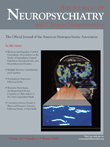Pseudobulbar Palsy and Affect in a Case of Progressive Multifocal Leukoencephalopathy
To the Editor: Pseudobulbar palsy, with its neuropsychiatric manifestation of pathological laughing and crying or pseudobulbar affect, has been described in a variety of CNS illnesses. 1 We present, with interest, a case of Pseudobulbar palsy in a patient with progressive multifocal leukoencephalopathy, a complication of AIDS. 2
Case Report
Our patient is a 39-year-old African American male whom we were asked to evaluate at our teaching hospital for an acute change of mental status. The patient’s past medical history was significant for AIDS.
On initial presentation, vital signs and physical examination were essentially within normal limits. However, his neurological examination was significant for bilateral upper extremity hyperreflexia; lower extremity reflexes were difficult to elicit due to the patient’s supine position. He had a positive babinski sign on the right and down-going toes on the left. The jaw-jerk reflex and gag reflex were slightly increased.
Our patient was treated for metabolic abnormalities and his mental status improved minimally. The patient received a magnetic resonance imaging (MRI) scan of the head which demonstrated several patches of signal abnormality involving subcortical white matter, brainstem, and cerebellum. The most likely diagnosis was postviral related demyelination due progressive multifocal leukoencephalopathy.
His psychiatric examination was significant for monotone, nasal speech. His affect was labile and he would easily burst into tears and laugh inappropriately to questions. Cognitively, the patient was oriented times one. His working and short-term memory were impaired.
In addition to a nasal dysarthria, our patient also experienced dysphagia. A barium swallow demonstrated aspiration of all consistency liquids. However, there were no abnormalities in relevant anatomy.
Nonetheless, our patient’s medical condition worsened, and unfortunately he expired before we could attempt treatment of his pseudobulbar affect.
Discussion
This case demonstrates a clinical picture of pseudobulbar palsy in a patient suffering from progressive multifocal leukoencephalopathy due to AIDS. Given our patient’s clinical symptoms, plus pseudobulbar affect and MRI findings, he seemed to have pseudobulbar palsy. Historically, pseudobulbar palsy is considered in the setting of vascular disorders, neurodegenerative disorders, and other CNS diseases. 1 While various lesions of the CNS may present with pseudobulbar palsy, typically corticobulbar fibers are involved. 1 Similar to our patient’s MRI, progressive multifocal leukoencephalopathy includes multiple areas of demyelination, 3 further substantiating our impression of pseudobulbar palsy.
Two predominate mechanisms have been proposed to explain pseudobulbar affect. One suggests disinhibition of the motor neurons controlling laughter and crying. Newer research suggests a reciprocal pathway exists between the cerebellum and the brainstem that adjusts laughter and crying responses, making them appropriate to context. 4
Pharmacologic interventions for pseudobulbar affect include the tricyclic antidepressants, serotonin reuptake inhibitors and a novel approach utilizing dextromethorphan and quinidine sulfate. Dextromethorphan, an N -methyl-D-aspartate receptor antagonist, inhibits glutamatergic transmission in the regions of the brainstem and cerebellum, which are hypothesized to be involved in pseudobulbar symptoms. Dextromethorphan acts as a sigma ligand, binding to the sigma-1 receptors that mediate the emotional motor expression. 5
We feel this case report illustrates that pseudobulbar palsy and pseudobulbar affect should be considered across a variety of CNS conditions.
1 . Moore D, Jefferson J: Pseudobulbar palsy, in Handbook of Medical Psychiatry, 2nd ed. Mosby, 2004, pp 302–303Google Scholar
2 . Mamidi A, DeSimone J, Pomerantz R: Central nervous system infections in individuals with HIV-1 infection. J Neurovirol 2002; 8:158–167Google Scholar
3 . Mark A, Atlas S: Progressive multifocal leukoencephalopathy in patients with AIDS: appearance on MR images. Radiology 1989; 173:517–529Google Scholar
4 . Keister GW: Pseudobulbar affect: keys to its cause and management. Applied Neurology 2006; 2(8)Google Scholar
5 . Brooks BR, Thisted RA, Appel SH, et al: Treatment of pseudobulbar affect in ALS with dextromethorphan/quinidine: a randomized trial. Neurology 2004; 63:1364–1370Google Scholar



